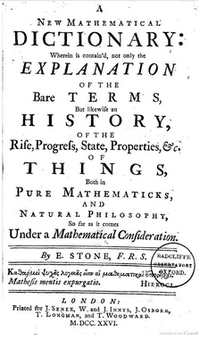Edmund Stone
| Edmund Stone | |
|---|---|
|
Frontpage of Mathematic Dictionary (1726) | |
| Born |
ca 1700 unknown, probably Argyllshire, Scotland |
| Died |
ca 1768 unknown |
| Fields | Mathematics |
Edmund Stone was an autodidact mathematician from Scotland in the 18th century.
Life and work
Practically nothing is known about the life of Edmund Stone. He was the son of the gardener of John Campbell, 2nd Duke of Argyll. He learned reading, latin, french and mathematics by himself. The Duke, knowing his abilities, protected him.[1]
Under his protection, he arrived in London in 1723 and published his first book: Treatise on Mathematical Instruments. In 1725 he was elected fellow of the Royal Society.
In the following years he published some papers in the Philosophical Transactions,[2] and his books Dictionary of Mathematics (1733) and a translation to english of Euclid's Elements (1728). He also published in 1730 The Method of Fluxions, both Direct and Inverse, whose first part is a translation of the book by L'Hôpital.[3]
From 1743, the death of the Duke, he seems to have lived in absolute poverty.
References
Bibliography
- Craik, George Lillie (1865). The pursuit of knowledge under difficultie. Bell and Daldy.
- Pierpoint, William S. (1997). "Edward Stone (1702–1768) and Edmund Stone (1700–1768): confused identities resolved". Notes and Records of the Royal Society of London. Vol. 51 (Num. 2): 211–217. doi:10.1098/rsnr.1997.0018. ISSN 0035-9149. PMID 11619434.
External links
- O'Connor, John J.; Robertson, Edmund F., "Edmund Stone", MacTutor History of Mathematics archive, University of St Andrews.
|
